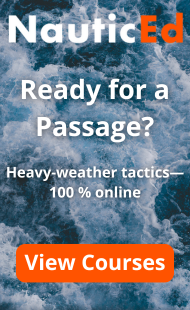Introduction
Preparing to sail offshore has always been challenging. As climate change intensifies and planetary boundaries are breached, preparation becomes even more challenging. Unfortunately, many climate impacts are arriving both sooner than expected and combining to be worse than forecast. From the entire north Pacific Ocean currently breaking heat records, to waterspouts in the Salish Sea, it is becoming easy to create a long list of present day and looming impacts. Such grim news does not have to mean discarding the cruising dream. However, when planning voyages it is prudent to consider the most recent science, have strategies for coping with these realities, and have contingencies prepared for worst cases.
This article provides a basic overview of some of the changing climate factors in play, then focuses on how some of these affect our physiology, brains and psychology. It then provides some practical suggestions to consider when preparing to sail offshore, using the example of sailing down the U.S. coast, to Mexico, and across the Pacific to New Zealand.
Scientific Context – It’s Getting Hotter Faster Than We Thought
Based on recent data and updated models, many researchers now think that near-term warming is occurring faster than predicted by the moderate models of the International Panel on Climate Change. Although ENSO (El Niño/La Niña) forecasts remain inherently uncertain, forecasters now think an El Niño is likely to begin in mid-2026.
What Faster Warming + El Niño Implies for Cruising
A. Weather and storms — more intensity, more surprises
- There is a higher tropical cyclone / hurricane risk in the eastern Pacific (off Mexico) during El Niño years, and risk of later-season storms.
- Extratropical storms and intense frontal systems (Northeast Pacific/ Southern Ocean approaches to New Zealand) are projected to change in intensity and pattern; climate change causes greater extremes (heavier precipitation, stronger peak winds). Expect rapidly intensifying, bigger, more energetic storms.
B. Ocean heat, marine heatwaves, and ecosystem effects
- Marine heatwaves are increasing in frequency, duration and intensity worldwide. Expect warmer sea surface temperatures, higher ocean acidity, and areas of reduced oxygen, with consequences such as altered currents, changing fish and mammal distributions, and toxic algal blooms.
- Severe coral bleaching means many reef anchorages across the Pacific will be damaged or dead and nearshore ecosystems and communities will be impacted.
C. Air quality & terrestrial hazards affecting offshore sailors
- Increased wildfire and smoke can create poor visibility and health hazards – even offshore. On land they can impact travel, sight-seeing, and local communities.
- Ports, marinas, services and supply chains are under stress in heat and extreme-weather events. Expect disruptions to fuel, spare parts, haul-outs, medical evacuations and other services.
Impact on Skippers, Crew, Couples, and Communities
1. Heat and Aggression
Scientific grounding:
- Multiple studies show a robust correlation between higher temperatures and increased aggression, violence, and conflict. Mechanisms include:
- Heat impairs sleep, hydration, and brain function. Heat, noise, motion and light disrupt circadian rhythms. Chronic circadian rhythm disruption raises aggression, impulsivity, and accident risk.
- Heat and dehydration affect serotonin and dopamine pathways linked to mood regulation.
- Physical, mental and emotional discomfort lowers tolerance and impulse control.
- Research finds increases in domestic violence, road rage, riots, etc. during heatwaves.
Implications for offshore sailors:
- Small irritations during crew interactions can escalate quickly in hot, cramped quarters. Sleep disruption (hot nights) amplifies tension.
- Couples on board may experience heightened conflict under heat stress; unresolved issues may surface.
- Local communities may experience heightened irritability and social stress during heat extremes, potentially affecting hospitality, service interactions, or safety.
Practical strategies:
- Enforce rest, hydration, and cooling breaks.
- Develop a crew protocol for conflict resolution before departure.
- Anticipate irritability during heat spikes — normalize it in crew briefings so sailors take a step back rather than escalate.
- Carry ventilation fans, breathable bedding, shading solutions, blackout masks and earplugs.
- Stick to consistent watch rotations.
2. Heat + Air Pollution (Compound Effects) and Cognitive Function
Scientific grounding:
- Heat worsens air pollution impacts:
- Ozone formation rises in hotter weather.
- Wildfire smoke persists longer and travels farther in heatwaves.
- Particulate matter (PM2.5) interacts with heat stress to raise cardiovascular and respiratory risk.
- Climate-related stress (heat, smoke, constant hazard monitoring) adds to the already high cognitive load of offshore sailing and strains cognitive function.
- Under sustained load, the brain defaults to habitual responses — sometimes helpful, but also dangerous if the habit doesn’t fit the situation.
- Decision fatigue increases risk of errors, freezing, or taking risky shortcuts.
Implications for offshore sailors:
- Hotter summers combined with wildfire smoke or urban pollution can make provisioning, maintenance, and paperwork physically and cognitively draining.
- Smoke plumes can extend far out to sea (e.g., 2023 Canadian wildfires). Visibility, respiratory health, and morale all suffer.
- Poor air quality plus heat impairs judgment, creating a serious safety risk during all aspects of sailing and especially during navigation and emergency decision-making.
- There is increased risk of poor judgment and decisions in port and when interacting with officials.
Practical strategies:
- Equip the boat with N95 masks, a small HEPA filter for cabin use, and saline sprays for airway relief. Where possible, seal up cabins and install air filter systems.
- Check smoke and air quality forecasts before port stops. Use air-quality monitoring devices and minimize smoke exposure on board.
- Plan strenuous repairs, paperwork and key decision-making for cooler, cleaner-air times of day.
- When offshore, seal hatches if downwind of wildfire smoke; use masks if exposure is prolonged.
- Rotate responsibility for high-stakes decisions.
- Use checklists to reduce cognitive strain.
- Use set decision protocols for key activities (e.g. reefing)
3. Heat and Disease Risk
Scientific grounding:
- Amoebic and bacterial risk:
- Brain eating amoeba (Naegleria fowleri) thrives in warm freshwater >30°C and is expanding in range.
- Cholera related bacteria (Vibrio bacteria) are expanding their range in warming seawater; these bacteria are linked to wound infections and food poisoning.
- Harmful algal blooms:
- Warmer waters plus nutrient runoff increases algae blooms.
- Many blooms produce neurotoxins (domoic acid, saxitoxin, brevotoxin) affecting shellfish and fish.
- Heat plus algae blooms create airborne neurotoxins. These and smoke pollutants can impair cognition and mood.
- Exposure may not cause acute illness but can erode general well-being and decision-making capacity.
- Warmer, wetter conditions expand mosquito ranges and the diseases they carry (dengue, Zika, chikungunya, malaria).
- Heat weakens human immune system responses, and wounds/injuries at sea are more prone to infection in warmer, bacteria-rich waters.
Implications for sailors:
- It may be unsafe to swim or bathe in overheated freshwater lagoons or rivers.
- Shellfish and reef fish in many tropical areas will carry higher toxin risk.
- Tropical stopovers may pose mosquito-borne disease threats.
- Crew injuries (cuts, scrapes) need fast and rigorous disinfection when in warm seas.
- Crew may appear “off” — slower reactions, muddled thinking — without obvious cause.
Practical strategies:
- Avoid freshwater immersion in very warm climates.
- Do not harvest fish or shellfish locally unless advised safe by health authorities.
- Stock broad-spectrum antibiotics and proper wound-care kits.
- Use mosquito nets, repellents, and long sleeves at dusk/dawn in tropical ports.
- Subscribe to algae bloom and marine health alerts.
- Closely monitor sailors’ health for early detection of issues.
4. Climate Anxiety, Grief, Trauma and Psychological Impacts
Scientific grounding:
- Climate anxiety: anticipatory stress, worry, depression and paralysis increase from awareness of the worsening crises.
- The loss of species, habitats, and ecosystems increases grief and the need for mourning.
- First-hand experience of coral bleaching, dead zones, stranded marine mammals, or devastated coastal towns can produce acute stress responses.
- Researchers emphasize that this isn’t just emotional but physiological.
Implications for sailors:
- Offshore crews may encounter dead or dying ecosystems (bleached reefs, mass fish kills, storm damage ashore). This can shake morale and increase the likelihood of hypervigilance, panic, dissociation, and trauma symptoms – raising the risk of PTSD-like symptoms.
- Long voyages amplify reflection and awareness — grief may come in waves, affecting focus and decision-making.
- Different people cope differently — some become more irritable, others withdrawn.
- Crew members who have been through disasters before (wildfires, floods, storms, etc.) may carry latent trauma that reactivates under new stress.
- Onboard, this can mean freezing during an emergency or overreacting aggressively.
Practical strategies:
- Acknowledge grief and trauma as part of the voyage: build space in on board culture for reflection and conversation.
- Integrate rituals or creative outlets: journalling, photography, small ceremonies for the losses observed.
- Get training in psychological first aid: recognize stress reactions in self and others. Create space for post-incident processing (not just “move on”).
- Plan to share experiences with sailing and ‘back home’ communities (logs, blogs, art, talks) so grief becomes fuel for meaning and action rather than isolation.
- Rotate responsibilities so no one steeps too long in negative emotions without relief.
5. Hope, Purpose, and Resilience
Scientific grounding:
- Just as climate grief undermines morale, meaning-making and purpose boost resilience.
- Positive psychological framing, awe, and communal rituals activate reward and bonding circuits, counterbalancing stress hormones.
Implications for sailors:
- Crews who cultivate purpose (e.g. we’re voyaging as witnesses, or storytellers for these ecosystems, or communities) show greater endurance and less conflict.
- Experiencing and acknowledging awe at the beauty and wonder of the open ocean, stars, and wildlife can buffer despair.
Practical strategies:
- Make space for storytelling, art, photography, and journal-keeping.
- Treat the voyage as a contribution e.g. citizen science.
- Build small rituals of gratitude or awe into the routine e.g. sunset watch, star naming, morning check-ins.
Conclusion
Heat interacts with human systems on multiple levels — aggression, cognition, disease, pollution exposure, and mental health. Offshore sailors will need to plan for physiological resilience, psychological care, and health protocols in a hotter, more volatile world.
Further Reading:
Impact of climate change on our brains: “The Weight of Nature: How a Changing Climate Changes Our Brains” by Clayton Aldern, 2024.
Climate change heating up: Potsdam Institute for Climate Impact Research, and talks by Leon Simons – “Climate Chat” on YouTube.






